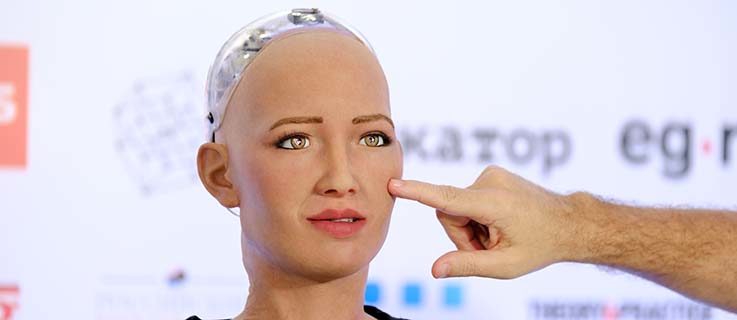Artificial intelligence is on the rise – as can be seen not only from the growing popularity of dialogue systems like Alexa. However, some key criteria still need to be met before it can serve as a substitute for a real-life language teacher: spontaneity, creativity and shared knowledge.
Artificial intelligence (AI) with a written or oral interface is supposed to make our lives easier in future. Assistants such as Siri (Apple) and Galaxy (Samsung) already allow smartphone functions to be operated via language recognition and synthesis software, while Amazon’s Alexa dialogue systems will soon be controlling our smart homes: companies based in Silicon Valley paint a vision of the future in which intuitive language interaction with a virtual interlocutor plays a vital role. AI is not only used to give a verbal command to one’s smartphone to play a particular playlist, but also features in far more complex scenarios such as online games and interactive toys with a language interface (like Mattel’s Hello Barbie), and as virtual tutors in e-learning environments (such as the virtual tutor Ed the Bot in SAP learning software). It therefore seems natural to take advantage of innovative technologies in foreign language teaching, too. They are able to make learning possible anywhere and at any time. Commercial providers and non-commercial institutions are developing applications that follow (and combine) entirely different technical approaches. This article provides a critical overview that will help to differentiate between them.
Basic technical concepts for language learning software
The conventional graphical user interface (+ speech recognition): language learners click their way through digital exercises that are highly reminiscent of those contained in traditional textbooks. The drag-and-drop function is used to match words with pictures or to fill the gaps in cloze texts. Strictly speaking, such learning scenarios do not even fall within the scope of AI research because they are based on a conventional desktop environment.
From a learning psychology perspective, the problem here is that it is mainly a question of moving predefined text blocks back and forth, so learners are given hardly any training in how to creatively and spontaneously formulate their own discussion contributions. Many of the commercial language learning apps work in this way – some are monolingual (
Rosetta Stone), some use translations (
Babbel). In didactic terms, even the market leaders base their apps on outdated concepts such as the translation method or pattern drills; this is because highly schematic formats are significantly easier to model.
Some of the apps are supplemented by language recognition software that is able to recognize spoken contributions – or not, if they happen to be mispronounced. Naturally, this can be no substitute for phonetics lessons given that the technical evaluation of audio data is based on entirely different criteria, such as assessing the probability of sound strings. Thus language recognition can be influenced by unclear pronunciation, whispering or background noise, or intentionally deceived by learners. Furthermore, the apps give no individual feedback about articulation. If learners simply receive an error message in response to repeated oral input, they are more likely to become frustrated than to improve their pronunciation.
Language interface with dialogue function: this is an attempt to simulate natural verbal interaction with a virtual tutor that can be described in a narrower sense as AI. These dialogue systems follow the principle of a simple chatbot that helps the learner to communicate intuitively in natural language. Learners are free to make oral contributions that the technology analyses for the presence of predefined key words. If the right key word is used, an appropriate predefined response from the artificial tutor is selected and output. The language input and output can be written or verbal. The English-language version of the language learning app
Duolingo for example works with a writing-based chatbot as tutor. The problem is that most systems respond merely to simple key words and have great difficulties evaluating whether input is grammatically correct – let alone appropriate to the situation. Such interactive artificial tutor systems work in clearly defined scenarios with predictable dialogues and corresponding error sources. In these contexts, they can teach new content, ask questions and give feedback at a predefined (and ideally selectable) pace of progression. However, this technology is not used nearly as widely in foreign language teaching as its potential might suggest. By contrast, it is already used to some extent in university teaching, such as in the e-tutorials on German linguistics, grammar and orthography that feature Leibniz Universität Hannover’s charming artificial tutor
El Lingo.
Virtual learning environments with pedagogical agent systems: dialogue systems featuring complex avatars capable even of gestures and facial expressions (embodiment) represent the most advanced development. At Bielefeld University, for example, a pedagogical agent called Max is being developed as a virtual museum guide. Museum visitors can chat to him about the exhibits – assuming they cooperate and do not deviate from the predefined dialogue scripts. In foreign language teaching, the problem is that interaction with the agent will only work smoothly if learners input the questions and answers that the system developers were able to foresee. Human responses are only predictable to a limited degree, however. Outside the scripted application areas, dialogues with chatbots and agent systems are erratic, incoherent and prone to error. They cannot serve as a role model for foreign language learners.
 Humans remain inimitable – just like their language
| Photo: © Colourbox
Big data analysis:
Humans remain inimitable – just like their language
| Photo: © Colourbox
Big data analysis: AI efficiency has improved hugely of late, thanks not least to the massive expansion of data storage. The analysis of large quantities of data via algorithms and statistical models can also be used for foreign language lessons – for translation exercises, for instance, and in the form of corpus-based dictionaries. The advantage of working with large collections of data containing empirical remarks made by native speakers is that the foreign language is learnt not as an abstract system but as it is actually used. On the other hand, one problem is that the information analysis relies on a predefined algorithm that does not always search for and deliver what it should. Access to large quantities of data should also improve dialogue systems like
Watson (IBM). To this end, the systems record every dialogue; this is extremely worrying from a data privacy perspective and should be given consideration when used in the classroom in the near future.
AI potential and limitations
So what is the potential of AI, and where are its limitations? In terms of interaction, it is a problem that the systems are designed on a purely deterministic basis – that is to say they follow one program and have access only to limited knowledge resources such as social or cultural knowledge. Human communication functions in precisely the opposite way. We assume that we share a great deal of knowledge, and are extremely efficient in the way we communicate only that which we recognize as being relevant to a specific interaction situation. At the same time, we are able to act spontaneously and flexibly. AI systems cannot do this because they lack one fundamental prerequisite: a self-reflective consciousness. While it may be the case that e-learning applications with graphical user interfaces will be able to replace analogue textbooks in the future, AI will not be able in the foreseeable future to replace real-life teachers. E-learning scenarios with artificial tutors are no substitute for classroom teaching; they are an entirely new approach to supporting learners in their self-study sessions. For some types of learners, practising vocabulary on an interactive basis with a pedagogical agent system or completing language exercises in a computer game with virtual characters is extremely motivating. Others learn better from social interaction in a real-life group of learners with the associated advantages such as having a genuine teacher to monitor learning progress.
Interactive language learning systems are also a useful means of filling a gap in situations where no lessons would otherwise take place. People who work full-time and do not have the time to attend regular classes for example can use learning apps to acquire basic language skills for an upcoming holiday. Furthermore, refugees can use GFL apps such as that offered by the Goethe-Institut to build up a basic vocabulary to bridge the long wait for an integration course. The technologies are thus suited solely for beginners as a means of supplementing or preparing for classroom lessons with a human teacher.
Literature
Lotze, Netaya (2016): Chatbots. Eine linguistische Analyse (Sprache – Medien – Innovation; 9).
